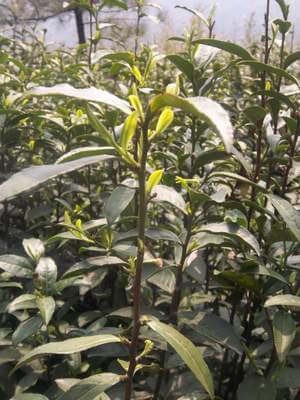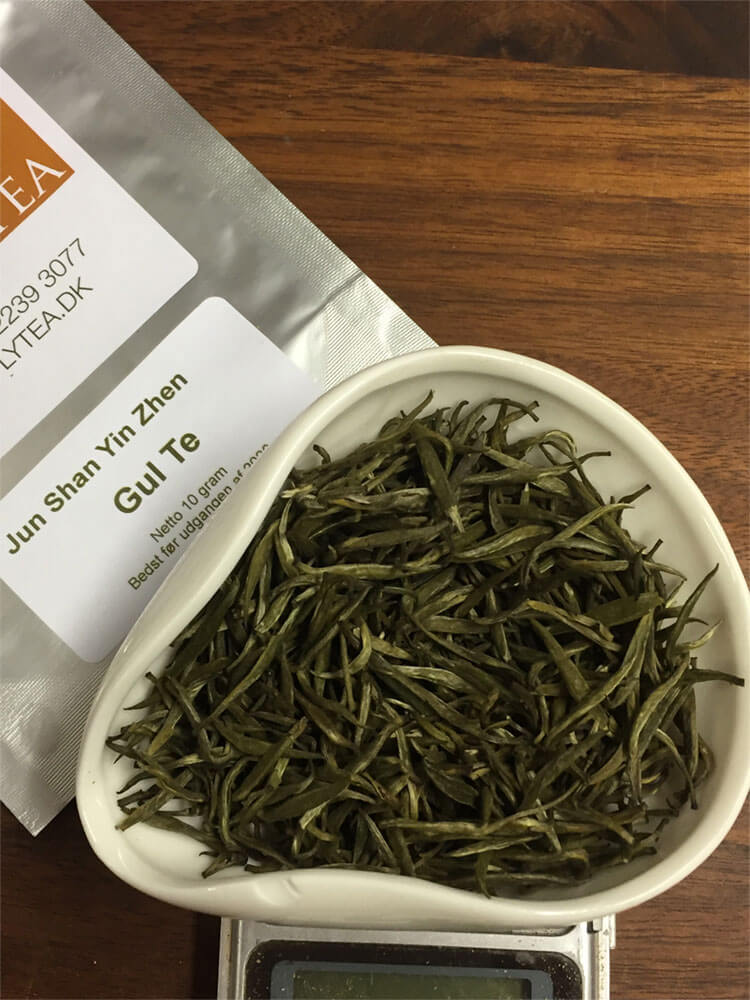What is yellow tea?
Yellow tea
Origin
Yellow tea is the rarest of all tea types and therefore one of the world’s most expensive teas. Yellow tea was very popular during China’s dynasties (1100-1912). The yellow color has always been reserved for the emperor, and so has yellow tea. It is believed that yellow tea first came into existence at the beginning of the Qing dynasty (1644-1912), where it was produced solely for the emperor.
The tea is very unique and is produced exclusively in the mountainous regions of China in the provinces of Anhui, Hunan, and Sichuan in very limited quantities.
The name huang ya means yellow buds, but it also defines the process where small amounts of tea leaves are wrapped in cloth or paper and allowed to mature under heat until they are dry.
Yellow tea has its own special production method called “making yellow” – and therefore deserves its own chapter.
Rare tea
Unfortunately, yellow tea is not very well known in the West and is often mistakenly referred to as green tea. Yellow tea, which has a bud and one to two leaves, resembles many hand-crafted green teas, which may explain this confusion.
Today, there are only three yellow teas left in China, and the knowledge required to continue the production of this tea is in imminent danger of being lost. Many of the tea masters who produced the famous yellow teas are now elderly or have passed away. China’s push to produce more and more green teas to meet the West’s increasing demand is unfortunately also contributing to the risk that the unique and wonderful yellow teas will disappear in the future.
The once-famous yellow tea, Huo Shan Huang Ya, no longer exists. Anhui, where it was produced, is a very poor area, and the technique for making yellow tea was lost because production costs had become too high. However, you can still find teas on the market under the name Huo Shan Huang Ya, but these are teas made as green tea. Many people still buy it believing it to be yellow tea.
To this day, three yellow teas have survived:
- Jun Shan Yin Zhen from Hunan – not to be confused with Bai Hao Yin Zhen (white silver needle),
- Meng Ding Huang Ya from Sichuan – and my (Alexis Kaae, founder of Simply Tea) favorite tea.
- Mo Gan Huang Ya from Zhejiang in southeastern China. It is the least known and rarest of the three yellow teas.
Production
Yellow tea can only be picked a few days a year in the earliest spring. The picking standard consists of one bud and one leaf (called: mao jian). Others consist of one bud and two very small leaves (mao feng). The spring buds contain the highest number of antioxidants and are therefore considered the healthiest.
It is extremely time-consuming to pick the tiny buds instead of the slightly larger leaves. A tea picker can pick 500-1000 grams a day, which shrinks to about a third in dried form.
The process of making yellow tea is also very resource-intensive and can take from one to three days. Each type of yellow tea has its own production process.
First, the enzymes are halted so that the leaves can retain their color and flavor, which is also the process used for most green teas. The enzymes are halted by roasting the tea buds in a wok at very high temperatures for a few seconds. It requires expertise to move the leaves without burning them and without the tea master burning their fingers. Often, there are several tea masters present who can quickly take over the roasting for each other when their fingers get too hot.
Afterward, the tea is rolled on a bamboo tray to reduce the heat. Here, the leaves are either wrapped in thick paper (Jun Shan Yin Zhen) or in cloth (Meng Ding Huang Ya and Mo Gan Huang Ya). Yellow tea is often classified alongside white tea because it is considered lightly oxidized, but the process during which it rests is more of a light microbial fermentation than oxidation. The special processing removes the slightly vegetal taste from the buds while retaining a tea with the same health qualities as white and green tea.
The now-wrapped tea leaves are placed in a small bamboo basket over a coke fire, while Yin Zhen is stored in a wooden box. The coke fire is covered with ash to prevent smoke from escaping. The small packages are periodically opened, cooled, and rewrapped – except for Mo Gan Huang Ya, which is also hand-rolled between repackaging.
This process helps to ferment the tea gradually, continuing for up to three days, allowing the tea to dry over an extended period. The process is time-consuming and difficult, resulting in a milder, sweeter, and more mature flavor than green tea, as well as a refreshing, cool sensation that lingers in the throat.
The purpose of making yellow tea is to remove the grassy nuance of green tea while maintaining the health benefits of green tea. Yellow tea is actually considered to be even healthier than green tea because it is easier on the stomach. For people with sensitive stomachs, yellow tea is often a gentler option than green tea. Due to its slow fermentation process, yellow tea is regarded by many as very beneficial for the spleen and stomach. It is good for correcting digestive issues, stimulating appetite, and aiding in weight loss. Additionally, yellow tea retains up to 85% of its EGCG content after processing. (EGCG is a catechin in tea that is valued for its cancer-inhibiting and anti-inflammatory properties.)
Recent scientific studies have found that yellow tea is rich in tea polyphenols, polysaccharides, vitamins, and amino acids. It has also been proven that the processing method increases the content of L-theanine, which helps provide a sense of well-being and relaxation.
At Risk of Extinction
When one gains insight into the processing time and combines it with the very short and limited harvest season, it becomes clear why this tea has had such difficulty surviving. It would likely have completely disappeared if not for the local people who value it highly for its health benefits and produce a few kilos each year.
It is truly a remarkable tea for tea enthusiasts. It has a wonderfully complex flavor and aroma. Hopefully, yellow tea will become better known in the future, so that demand for it can increase and we can help ensure that this very rare tea does not disappear. Annually, less than 1000 kilos of yellow tea are produced in China.
Brewing Yellow Tea
Warm a small teapot, gaiwan, or cup with 80-degree Celsius hot water. Add about 2 grams (or a flat tablespoon) of yellow tea leaves. Pour 80-degree Celsius hot water over the leaves and let the tea steep for 3-4 minutes. Enjoy between 3 and 5 infusions.
If you want to learn more about yellow tea or other teas, you can sign up for one of Simply Tea’s tea tasting courses.




